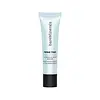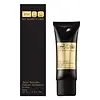What's inside
What's inside
 Key Ingredients
Key Ingredients

 Benefits
Benefits

 Concerns
Concerns

 Ingredients Side-by-side
Ingredients Side-by-side

Water
Skin ConditioningCaprylic/Capric Triglyceride
MaskingGlycerin
HumectantCaprylic/Capric/Succinic Triglyceride
EmollientDicaprylyl Carbonate
EmollientGlyceryl Stearate
EmollientSodium Stearoyl Glutamate
CleansingCetearyl Alcohol
EmollientTocopherol
AntioxidantMalus Domestica Fruit Cell Culture Extract
Skin ConditioningKappaphycus Alvarezii Extract
Skin ConditioningCaesalpinia Spinosa Fruit Extract
Skin ProtectingEuterpe Oleracea Fruit Oil
Skin ConditioningHelianthus Annuus Seed Oil
EmollientXanthan Gum
EmulsifyingLecithin
EmollientTin Oxide
AbrasiveSynthetic Fluorphlogopite
Polyacrylate Crosspolymer-6
Emulsion StabilisingMica
Cosmetic ColorantHydroxyacetophenone
AntioxidantEthylhexylglycerin
Skin ConditioningCellulose
AbsorbentTetrasodium Glutamate Diacetate
Sodium Hydroxide
BufferingAscorbyl Palmitate
AntioxidantCitric Acid
BufferingPhenoxyethanol
PreservativeIron Oxides
CI 77891
Cosmetic ColorantWater, Caprylic/Capric Triglyceride, Glycerin, Caprylic/Capric/Succinic Triglyceride, Dicaprylyl Carbonate, Glyceryl Stearate, Sodium Stearoyl Glutamate, Cetearyl Alcohol, Tocopherol, Malus Domestica Fruit Cell Culture Extract, Kappaphycus Alvarezii Extract, Caesalpinia Spinosa Fruit Extract, Euterpe Oleracea Fruit Oil, Helianthus Annuus Seed Oil, Xanthan Gum, Lecithin, Tin Oxide, Synthetic Fluorphlogopite, Polyacrylate Crosspolymer-6, Mica, Hydroxyacetophenone, Ethylhexylglycerin, Cellulose, Tetrasodium Glutamate Diacetate, Sodium Hydroxide, Ascorbyl Palmitate, Citric Acid, Phenoxyethanol, Iron Oxides, CI 77891
Water
Skin ConditioningGlycerin
HumectantC13-15 Alkane
SolventDicaprylyl Carbonate
EmollientEthylene/Acrylic Acid Copolymer
Emulsion StabilisingC12-16 Alcohols
EmollientSodium Polyacrylate
AbsorbentPalmitic Acid
EmollientSodium Potassium Aluminum Silicate
Phenoxyethanol
PreservativeSodium Stearoyl Glutamate
CleansingHydrogenated Lecithin
EmulsifyingHydroxyethyl Acrylate/Sodium Acryloyldimethyl Taurate Copolymer
Emulsion StabilisingEthylhexylglycerin
Skin ConditioningCaprylyl Glycol
EmollientSilica
AbrasiveDisodium EDTA
Sodium Hydroxide
BufferingParfum
MaskingPolysorbate 60
EmulsifyingSorbitan Isostearate
EmulsifyingSodium Hyaluronate
HumectantPoloxamer 338
EmulsifyingPEG-8
HumectantTocopherol
AntioxidantCirsium Eriophorum Callus Extract
AstringentMica
Cosmetic ColorantAscorbyl Palmitate
AntioxidantAscorbic Acid
AntioxidantCitric Acid
BufferingTocopheryl Acetate
AntioxidantCI 77891
Cosmetic ColorantCI 77491
Cosmetic ColorantWater, Glycerin, C13-15 Alkane, Dicaprylyl Carbonate, Ethylene/Acrylic Acid Copolymer, C12-16 Alcohols, Sodium Polyacrylate, Palmitic Acid, Sodium Potassium Aluminum Silicate, Phenoxyethanol, Sodium Stearoyl Glutamate, Hydrogenated Lecithin, Hydroxyethyl Acrylate/Sodium Acryloyldimethyl Taurate Copolymer, Ethylhexylglycerin, Caprylyl Glycol, Silica, Disodium EDTA, Sodium Hydroxide, Parfum, Polysorbate 60, Sorbitan Isostearate, Sodium Hyaluronate, Poloxamer 338, PEG-8, Tocopherol, Cirsium Eriophorum Callus Extract, Mica, Ascorbyl Palmitate, Ascorbic Acid, Citric Acid, Tocopheryl Acetate, CI 77891, CI 77491
Ingredients Explained
These ingredients are found in both products.
Ingredients higher up in an ingredient list are typically present in a larger amount.
Ascorbyl Palmitate is created by combining pure Vitamin C and palmitic acid. It is an antioxidant and helps reduce hyperpigmentation.
This ingredient is a more stable version of Vitamin C, meaning it does not disintegrate as quickly when exposed to sunlight. However, studies show it does not penetrate skin as well as pure Vitamin C.
Ascorbyl Palmitate is oil soluble.
Read more about other types of Vitamin C:
Learn more about Ascorbyl PalmitateCi 77891 is a white pigment from Titanium dioxide. It is naturally found in minerals such as rutile and ilmenite.
It's main function is to add a white color to cosmetics. It can also be mixed with other colors to create different shades.
Ci 77891 is commonly found in sunscreens due to its ability to block UV rays.
Learn more about CI 77891Citric Acid is an alpha hydroxy acid (AHA) naturally found in citrus fruits like oranges, lemons, and limes.
Like other AHAs, citric acid can exfoliate skin by breaking down the bonds that hold dead skin cells together. This helps reveal smoother and brighter skin underneath.
However, this exfoliating effect only happens at high concentrations (20%) which can be hard to find in cosmetic products.
Due to this, citric acid is usually included in small amounts as a pH adjuster. This helps keep products slightly more acidic and compatible with skin's natural pH.
In skincare formulas, citric acid can:
While it can provide some skin benefits, research shows lactic acid and glycolic acid are generally more effective and less irritating exfoliants.
Most citric acid used in skincare today is made by fermenting sugars (usually from molasses). This synthetic version is identical to the natural citrus form but easier to stabilize and use in formulations.
Read more about some other popular AHA's here:
Learn more about Citric AcidDicaprylyl Carbonate comes from carbonic acid and caprylyl alcohol, a fatty alcohol. It is an emollient and gives skin a velvet feel. The sources of Dicaprylyl Carbonate may be synthetic or from animals.
As an emollient, Dicaprylyl Carbonate creates a film on the skin. This film traps moisture in, keeping your skin soft and hydrated.
Ethylhexylglycerin (we can't pronounce this either) is commonly used as a preservative and skin softener. It is derived from glyceryl.
You might see Ethylhexylglycerin often paired with other preservatives such as phenoxyethanol. Ethylhexylglycerin has been found to increase the effectiveness of these other preservatives.
Glycerin is already naturally found in your skin. It helps moisturize and protect your skin.
A study from 2016 found glycerin to be more effective as a humectant than AHAs and hyaluronic acid.
As a humectant, it helps the skin stay hydrated by pulling moisture to your skin. The low molecular weight of glycerin allows it to pull moisture into the deeper layers of your skin.
Hydrated skin improves your skin barrier; Your skin barrier helps protect against irritants and bacteria.
Glycerin has also been found to have antimicrobial and antiviral properties. Due to these properties, glycerin is often used in wound and burn treatments.
In cosmetics, glycerin is usually derived from plants such as soybean or palm. However, it can also be sourced from animals, such as tallow or animal fat.
This ingredient is organic, colorless, odorless, and non-toxic.
Glycerin is the name for this ingredient in American English. British English uses Glycerol/Glycerine.
Learn more about GlycerinMica is a naturally occurring mineral used to add shimmer and color in cosmetics. It can also help improve the texture of a product or give it an opaque, white/silver color.
Serecite is the name for very fine but ragged grains of mica.
This ingredient is often coated with metal oxides like titanium dioxide. Trace amounts of heavy metals may be found in mica, but these metals are not harmful in our personal products.
Mica has been used since prehistoric times throughout the world. Ancient Egyptian, Indian, Greek, Roman, Aztec, and Chinese civilizations have used mica.
Learn more about MicaPhenoxyethanol is a preservative that has germicide, antimicrobial, and aromatic properties. Studies show that phenoxyethanol can prevent microbial growth. By itself, it has a scent that is similar to that of a rose.
It's often used in formulations along with Caprylyl Glycol to preserve the shelf life of products.
Sodium Hydroxide is also known as lye or caustic soda. It is used to adjust the pH of products; many ingredients require a specific pH to be effective.
In small amounts, sodium hydroxide is considered safe to use. However, large amounts may cause chemical burns due to its high alkaline.
Your skin has a natural pH and acid mantle. This acid mantle helps prevent harmful bacteria from breaking through. The acid mantle also helps keep your skin hydrated.
"Alkaline" refers to a high pH level. A low pH level would be considered acidic.
Learn more about Sodium HydroxideSodium Stearoyl Glutamate is an emulsifier and helps condition the skin. It is amino acid-based.
In higher amounts, it may act as a cleansing agent.
Tocopherol (also known as Vitamin E) is a common antioxidant used to help protect the skin from free-radicals and strengthen the skin barrier. It's also fat soluble - this means our skin is great at absorbing it.
Vitamin E also helps keep your natural skin lipids healthy. Your lipid skin barrier naturally consists of lipids, ceramides, and fatty acids. Vitamin E offers extra protection for your skin’s lipid barrier, keeping your skin healthy and nourished.
Another benefit is a bit of UV protection. Vitamin E helps reduce the damage caused by UVB rays. (It should not replace your sunscreen). Combining it with Vitamin C can decrease sunburned cells and hyperpigmentation after UV exposure.
You might have noticed Vitamin E + C often paired together. This is because it is great at stabilizing Vitamin C. Using the two together helps increase the effectiveness of both ingredients.
There are often claims that Vitamin E can reduce/prevent scarring, but these claims haven't been confirmed by scientific research.
Learn more about TocopherolWater. It's the most common cosmetic ingredient of all. You'll usually see it at the top of ingredient lists, meaning that it makes up the largest part of the product.
So why is it so popular? Water most often acts as a solvent - this means that it helps dissolve other ingredients into the formulation.
You'll also recognize water as that liquid we all need to stay alive. If you see this, drink a glass of water. Stay hydrated!
Learn more about Water